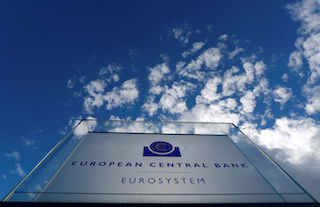LONDON – The European Central Bank’s decision to introduce a tiered interest rate may be inadvertently tightening rather than easing market conditions, dampening some of the impact from its move to cut interest rates and resume bond purchases.
On Tuesday, euro zone money market futures revealed a scaling back of bets on another near-term rate cut from the ECB, with the curve significantly steeper than it was before the Sept 12 ECB meeting.
The ECB last week cut interest rates by 0.10%, resumed a bond-buying programme and introduced tiered rates for banks. That means banks are partly exempted from paying annual ECB charges on their excess reserves, helping mitigate the effect of low rates on lenders’ profits.
Analysts and investors are still scratching their heads over the full impact of the ECB’s moves, but two implications appear to be clear.
First, under the tiered rate system banks are allowed to hold excess cash of up to six times their mandatory reserves without having to pay the penalty charge. They will now be charged 0% for parking excess reserves up to that limit at the central bank, rather than the deposit rate of -0.50%.
Markets have interpreted the move as a de facto rate increase.
This in turn has steepened the money market curve as investors bet the ECB will be reluctant to cut rates again soon.
Eonia money market futures dated to the ECB’s December meeting show just a 25 percent chance of a 10 basis point rate cut — having fully priced such a move just ahead of Thursday’s ECB meeting.
Another ECB cut is not fully priced in now until April 2020.
“The best way of summarising it is that we essentially saw a bit of a rate hike last week, combined with forward guidance and QE to overall make it a dovish package,” said Kacper Brzezniak, portfolio manager at Allianz Global Investors.
“If you take a weighted average of that (the tiered rates system) that takes rates to minus 30 bps, which is why you’ve seen the front-end of the yield curve react quite negatively.”
Another side effect of the tiered rate policy has been a selloff in short-dated bonds.
In euro zone benchmark bond issuer Germany, two-year bonds yields have risen around 10 basis points since the ECB meeting to trade near three-month highs of -0.64%.
Analysts said the tiering decision would reduce demand for short-dated bonds from banks, given the much more favourable terms under tiering compared to buying short-term assets with negative rates.
Tiering makes it more attractive for banks to park part of their excess liquidity at the ECB and reduces the need to hold short-dated government bonds, which have deeply negative yields.
“They have effectively reduced excess liquidity; that is not a desirable outcome,” said Peter Chatwell, head of rates strategy at Mizuho.
“The reason that the Eonia curve has gone higher is that the tiering of deposit facility was relatively generous compared to the 10 bps cut delivered,” he added.
Analysts say that the tiered deposit rate and recent market reaction suggests that policy rates have approached an effective lower bound.
“The fact that the asset purchase programme is open-ended can point towards an ECB more willing to adjust timing of asset purchases rather than cutting deposit rates,” said Natixis fixed income strategist Jean-Christophe Machado.
Instead of cutting rates, the ECB could buy more and longer-dated paper to boost stimulus, he suggested.
The ECB’s two-tier system will be implemented from Oct. 30, just after the bank’s next policy decision on Oct. 24.
The bank has said that it will set the multiplier in a way that euro short-term money market rates are not “unduly influenced”. It can change both the multiplier or the rate it applies on exempt reserves over time.
“If Eonia rates are rising, it would be an unintended effect, (so) you (would) have to adapt some parameters,” said KBC rate strategist Mathias van der Jeugt.
(Content & Photos Syndicated Via Reuters)
(Reporting by Yoruk Bahceli, additional reporting by Dhara Ranasinghe; editing by Sujata Rao/William Maclean)
